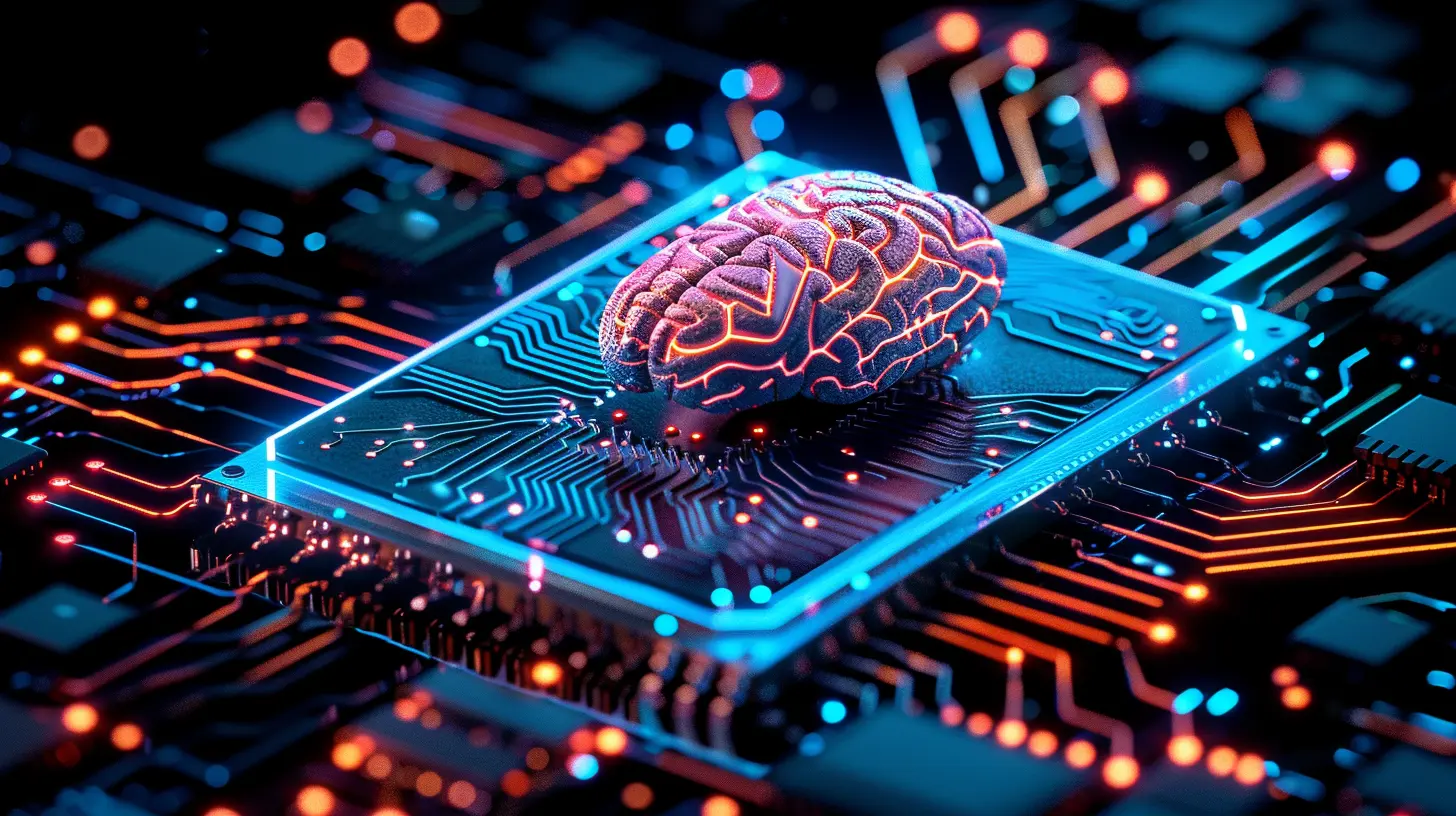The Impact of Neuromorphic Computing on AI Evolution
15 November 2025
Artificial Intelligence is growing like wildfire, but let's be honest—there's still a long road ahead before machines truly think like us. I mean, sure, we’ve got AI that can write poems, diagnose illnesses, or even win at Jeopardy, but they’re not really “thinking.” Not the way you and I do. That’s where neuromorphic computing comes swooping in like the hero we've been waiting for.
What if we told you there's a way to make computers more human in the way they process information? That’s not science fiction anymore—it’s neuromorphic magic. Let’s unpack how this game-changing technology is reshaping the evolution of AI and why you should definitely keep it on your radar.
What Exactly Is Neuromorphic Computing?
Let’s start with the basics. Neuromorphic computing is a fancy term for building computer systems that mimic the structure and behavior of the human brain. Instead of using traditional digital circuits, neuromorphic chips use neural networks, synapses, and neurons—just like your good ol' noggin.These chips don’t just simulate the brain's function—they actually emulate it electrically. That means the hardware itself is designed to think, learn, and adapt much more like a biological brain, not just software stacked on top of a processor.
It’s like switching from using a calculator (traditional AI) to building an actual mini brain inside your device. Sounds cool? It’s revolutionary.
Why the Brain Is Still the GOAT of Processing Power
Ever wonder why your brain can do a million things at once, all while sipping coffee and scrolling Instagram?Well, here’s the kicker: our brains are massively parallel, low-power consumption machines that are insanely efficient. While the average human brain uses about 20 watts of power, AI systems today can require megawatts just to train a single model.
In fact, brains are so good at tasks like pattern recognition, learning, and adapting, that we’ve basically hit a wall trying to replicate this with conventional computing. That’s where neuromorphic computing steps in—with the promise of speed, efficiency, and scalability.
The Bridge Between AI and Human-Like Intelligence
Now let’s get this straight—AI today is powerful, no doubt. But it often lacks what we call general intelligence. You know, the kind that lets you learn a skill in one area and apply it in another. Current AI is like a super-efficient worker who’s a genius at one task but totally clueless elsewhere.Neuromorphic computing could change that.
Because these systems are built to mimic the brain’s architecture, they are inherently better at unsupervised learning, real-time processing, and context understanding. That means they’re not just fast—they’re smart.
Want your AI assistant to actually understand how you feel at the moment? Neuromorphic chips could make that possible.
Key Features That Make Neuromorphic Computing a Gamechanger
Let’s hit pause for a sec and bullet this out. Here are the killer features of neuromorphic systems:- 🧠 Brain-like processing — They use spiking neural networks (SNNs), which process data more like biological neurons.
- ⚡ Ultra-low power consumption — Ideal for edge devices where power is limited.
- 🚀 Real-time learning and adaptation — No need for retraining on massive datasets.
- 🤝 Massive parallelism — Multiple computations at the same time, just like neurons firing in your brain.
- 🧩 Event-driven architecture — They only compute when there’s input, saving resources.
This isn’t just faster AI—it’s smarter, more adaptable AI.
Real-World Applications Already Making Waves
Okay, so this sounds amazing in theory—but is it actually being used anywhere? Short answer: Yup. And it’s cooler than you’d think.1. Edge AI Devices
Ever wish your smart home camera could recognize faces faster without sending data back to the cloud? Neuromorphic chips make that happen. Because they’re low-power and real-time, devices like drones, surveillance cameras, and wearables benefit massively.2. Robotics
In the world of robotics, being able to adapt quickly and learn from the environment is everything. Neuromorphic systems allow robots to process sensory data (like touch, vision, or sound) just like humans do, making them more responsive and less clunky.3. Autonomous Vehicles
Self-driving cars need to process boatloads of information every millisecond. Neuromorphic computing can help them make faster, smarter decisions with less energy drain. That’s a win-win.4. Healthcare & Brain-Machine Interfaces
Think prosthetics that respond to neural signals in real time, or brain-computer interfaces for patients with neurological disorders. Neuromorphic chips are making sci-fi-style medicine very real.Big Players Betting on Neuromorphics
Still think this tech is too fringe? Think again.Tech giants like Intel, IBM, and Qualcomm are already deep into neuromorphic R&D. Take Intel’s Loihi chip, for example—it’s basically a neuromorphic powerhouse designed to fuel next-gen AI models with minimal power.
Even governments and academic institutions are diving in, seeing the insane potential this holds not just for AI, but for computing as a whole.
How Neuromorphic Computing Is Evolving AI Architecture
Hold tight, because this is where it gets really juicy. Traditional AI models require training using backpropagation and enormous labeled datasets. That’s computationally intensive and frankly, not scalable in the long-term.Neuromorphic systems flip the script. They use spiking neural networks, which are far better at:
- Learning from temporal sequences of data (like sounds or motion).
- Incorporating feedback loops for more dynamic decision-making.
- Performing on-device learning, reducing reliance on cloud processing.
This is AI 2.0—less brawn, more brains.
Challenges and Roadblocks Ahead
Alright, let’s not sugarcoat it. As exciting as this all sounds, neuromorphic computing isn’t quite plug-and-play yet.For starters, writing software for these chips is really complex. We’re talking a whole new paradigm of computation. Most AI developers today are trained to work with GPUs and CPUs—not neural mimicry tech.
And of course, scalability is another concern. Can we build millions of these chips for commercial use at a reasonable price? That’s still up in the air.
But remember: every groundbreaking tech started somewhere. The internet wasn’t built in a day, right?
The Future: What’s Next for AI with Neuromorphic Chips?
So what’s the endgame here? Well, imagine this: AI that can learn like you, feel like you (emotionally speaking), and adapt like you—in real time, on low power, with no constant need for the cloud.We're talking about personalized AI companions that understand you deeply, self-driving cars that navigate like seasoned drivers, and robots that learn from one mistake instead of hundreds.
Neuromorphic computing is like adding steroids to the brains of machines—with a healthy dose of empathy and intuition baked in.
Why You Should Care (Even If You’re Not a Techie)
Let’s bring it back home. You might not be building AI models or soldering chips in your garage, but this tech will affect all of us. From smarter smartphones to more responsive medical tech, the impact of neuromorphic computing will ripple through industries—and into our daily lives.This is not just another cool buzzword. It’s the next frontier. And getting in the know now is like owning a piece of the internet in 1995.
Final Thoughts: A Brainy Leap Forward
The impact of neuromorphic computing on AI evolution isn’t just a technical upgrade. It’s a philosophical shift. We're moving from machines that calculate—fast and rigid—to machines that reason, learn, and maybe even empathize.It’s early days, but the future is looking more human than ever—thanks to circuits that actually think like us.
So, next time you ask Siri a question or your car self-parks like a pro, just remember—there’s a new kind of brain behind it, and it might just be smarter than you think.
all images in this post were generated using AI tools
Category:
Future TechAuthor:

Reese McQuillan

